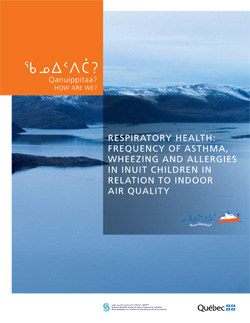A respiratory health survey on a representative sample (1023) of Inuit children aged 0 to 14 was undertaken for the first time in Nunavik in 2004. The data on respiratory symptoms and asthma were obtained from a household respondent, usually a parent, by means of the standardized ISAAC questionnaire (International Study of Asthma and Allergies in Childhood). Other questions were also asked about various home and environmental variables.
Results indicate that the prevalence of wheezing, persistent wheezing and severe wheezing is three to four times higher in the 0 to 4 age group compared to the 5 to 14 age group (14.5% vs. 3.4%). In comparison with southern Quebec and many countries, the prevalence of wheezing in younger Inuit children is relatively high, while it is relatively low among older children. The prevalence of wheezing among Inuit children aged 5 to 14 is about half the prevalence of wheezing found in children from southern Quebec aged 9 to 13, and is similar to the prevalence in countries at the low extremity of the worldwide distribution of asthma prevalence. On the other hand, the prevalence of lifetime or current asthma among Inuit children aged 5 to 14 is almost double that of the 0 to 4 age group.
Only 5.6% of children have allergies, which are associated with a higher risk of current asthma, persistent or severe wheezing. About 50% of children with wheezing took asthma medication in the two days prior to the survey. The prevalence of the use of asthma medication is 5.3% in the general Inuit population (adults and children combined).
Smoking restrictions are present in 84.1% of Inuit homes. No significant association was found between asthma or wheezing and passive smoking. The prevalence of asthma or wheezing was not statistically associated with the number of children aged 0 to14 in the household.
From a public health perspective, these results are quite encouraging. Indeed, we found a low frequency of allergy and asthma symptoms in 5-to- 14-year-old children, a high level of smoking restriction in Inuit homes and the absence of a documented negative effect of overcrowding on Inuit children. However, the results concerning the relatively high frequency of wheezing in the 0 to 4 age group, the proportion of children with persistent and severe wheezing, and the frequent use of asthma medication could suggest difficulty in controlling respiratory symptoms. Lower respiratory tract infections may play a major role. More research is needed to evaluate the clinical aspects of wheezing episodes and to estimate the adequacy of asthma control in this population.


